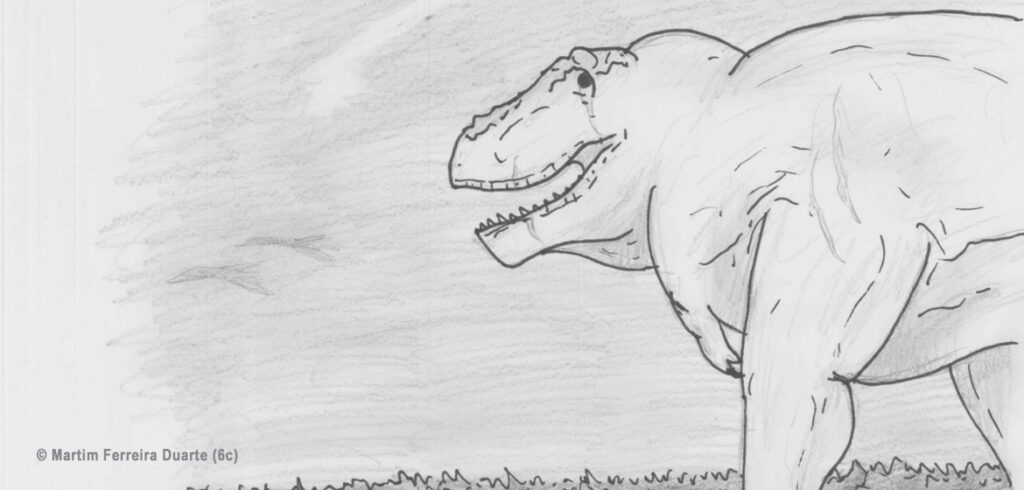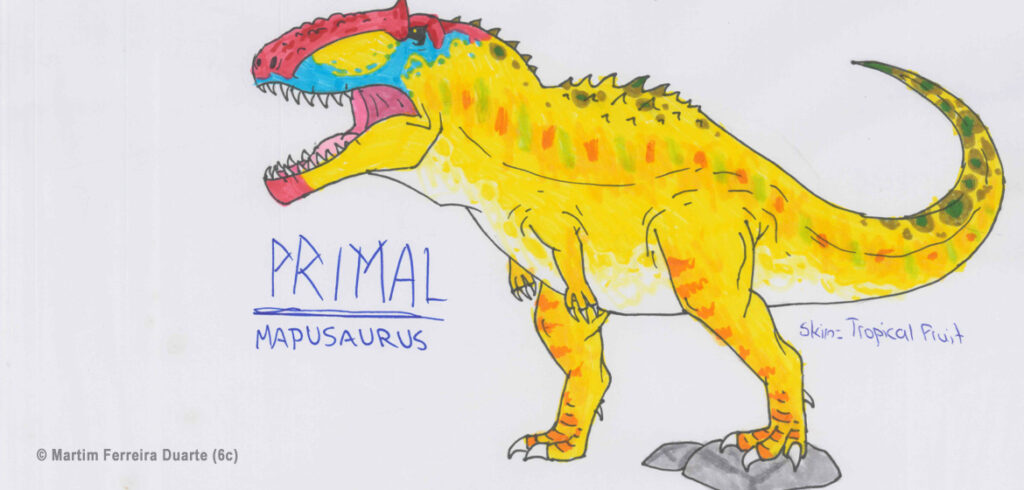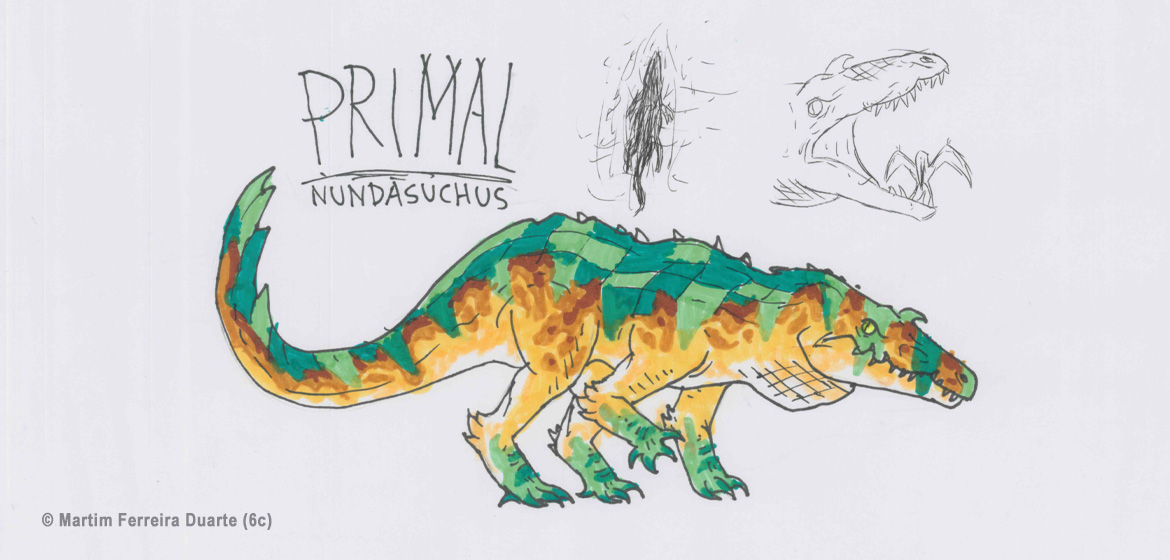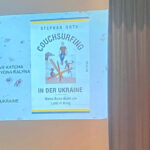Im Rahmen des Biologieunterrichts hat Martim Duarte (Klasse 6c) informative englische Texte zum Thema Dinosaurier verfasst. Doch damit nicht genug: In seiner Freizeit zeichnet und malt er mit großer Begeisterung Dinosaurier und erweckt die Urzeitwesen mit viel Kreativität zum Leben.
Wir möchten nicht nur seine Texte, sondern auch seine beeindruckenden Zeichnungen würdigen und hier online präsentieren. Vielen Dank an Martim für seinen Einsatz, seine Fantasie und seine tollen Beiträge!
Dinosaur Speculation
1: Feathered Tyrants?
A common question/speculation spinning around one of the famous, if not the most famous, dinosaurs is what I like to call the „Feathered Tyrants“. This theory basically says that several large tyrannosaurs had feathers. This theory is heavily supported by fossils of basal tyrannosaurs such as Dilong, Guanlong, Nanuqsaurus, Yutyrannus and Sinotyrannus. It’s speculated that the Nanuqsaurus had feathers for insulation since it lived in a climate where it could get -2 Degrees Celsius, and it would probably not see the sun for 120 days in a row. The same reasons apply to Yutyrannus. Meanwhile, the idea of Guanlong and Sinotyrannus being feathered is mainly based on the fact that Dilong is confirmed to have feathers (proved by the fossil record). Dilong is a very basal tyrannosauroid from China. And what a coincidence, so is Guanlong, Sinotyrannus and Yutyrannus (With Yuty. and Dilong having being found in the Yixian Formation, the Guanlong Shishou Formation and the Sinotyrannus in the Jiufotang Formation).

Although they are found in different fossil Formations in China, there’s a possibility that these predators coexisted since only 10% or less of an ecosystem gets fossilized. Nanuqsaurus, though, was found in North America, possibly because of some land bridge through northern Asia. Theres no evidence of a descendent or something that evolved from this tyrannosaurs. The conclusion is: early tyrannosaurs may have had feathers, although there’s no evidence or reason that shows that later tyrannosaurs had them too. This early family of tyrannosaurs in particular, made out of Dilong, Guanlong and Sinotyrannus, seems to be an evolutionary dead end, and never evolved to another species before dying out.
So, did T.Rex have feathers? Counting on the climate it lived in and its roots, the answer to that question is, most likely, no.
Sources: Wikipedia:
Yixian Formation: https://de.wikipedia.org/wiki/Yixian-Formation
Shishou Formation: https://en.wikipedia.org/wiki/Shishugou_Formation
Jiufotang Formation: https://de.wikipedia.org/wiki/Jiufotang-Formation
Dinosaurs:
Yutyrannus: https://en.wikipedia.org/wiki/Yutyrannus
Guanlong: https://en.wikipedia.org/wiki/Guanlong
Dilong: https://en.wikipedia.org/wiki/Dilong
Tyrannosaurus: https://en.wikipedia.org/wiki/Tyrannosaurus
Nanuqsaurus: https://en.wikipedia.org/wiki/Nanuqsaurus
Sinotyrannus: https://en.wikipedia.org/wiki/Sinotyrannus
2: Non-existing „Losers“ And Possible Giants
In paleontology, specimens who are made out of bones of several creatures are called Chimeras (the term derives from a ancient monster said to have parts of a lion, goat, etc…). There are several known examples of this, with the most recent ones being the Dakotaraptor, dismissed as a chimera, and the Saurophaganax, once in the top 10 largest theropods and now considered as sauropod bones and large allosauroid bones, who are now a new species of Allosaurus, Allosaurus anax, and is now the 11th largest theropod.

A more known case is Troodon, known only for a set of teeth. It is still a debate if it should be classified as a valid species or not. It was considered a “wastebasket taxon”, where things were classified when they didn’t know where else to put them, which might probably destroy some childhood imaginations. This also happened with Megalosaurus, who is still valid, yet was also one of the most common waste-basket taxon.
Another example who is not a chimera, but what i like to call the „Meta Dubium“, which means when one species turns out to be a growth stage of another, already known species. That happened with Dracorex and Stygimoloch, who were dismissed as the juvenile and sub-adult stages of Pachycephalosaurus. Next is kind of a fun fact. The first name given to T. Rex was Manospondylus gigas. People just forgot about that name and moved on to the much cooler Tyrannosaurus Rex.
Another nomen dubnium is the Ultrasaurus of the Morrison formation. Once considered the largest dinosaur ever, it is now known that the holotype was just a chimera of Brachiosaurus and Supersaurus.
Nevertheless, there will probably still be many more to come.
Dakotaraptor and another more popular case, the Nanotyrannus, are both trying to fill in the missing gap of an medium sized predator in the Hell Creek Formation.
3. Not Gentle Giants: Herbivores Who Defeated Their Predators

Ankylosaurus: This living tank lived with T.Rex. Although the bite force of the T.Rex was definitely enough to bite through any armor, a study suggests that a fast swing from it’s tail was more then enough to break through T.Rexes leg bones.
Sauropods: Most titanic sauropods ruled their environment by being simply too big for even full-grown predators to attack them. This ruling of the ecosystem is nicely showed by Alamosaurus, Brachiosaurus, Apatosaurus and Argentinosaurus.
Shantungosaurus: This hadrosaur was the biggest non-sauropod dinosaur ever, and would have weight up to 18 tons, almost two times bigger than T.Rex. This size was well needed to fend of the giant Zhuchengtyrannus, a large tyrannosaur.
Triceratops: This horned menace would be the only thing capable of injuring or even killing a adult T.Rex. It would have weighed as much, and would probably stay in herds, making predation almost impossible. This is supported by the T.Rex specimen TMT v222 (Lee), who has a wound caused by a Triceratops horn.
MEGATHEROPODS:
THEROPODS OVER 5000 KG
Tameryraptor 10.6m, 5-5.2 tonnes.
Oxalaia 11.54m, 5.4 tonnes.
Torvosaurus tanneri 11.4m, 5.2 tonnes.
Torvosaurus gurneyi 10.4m, t-5.2 tonnes.
Tarbosaurus 10.57m, 5.3 tonnes.
Zhuchengtyrannus 10.5m, 5.3+ tonnes.
Acrocanthosaurus 11.54m, 5.4 tonnes.
Therizinosaurus ~9.5m, 5.5 tonnes.
Taurovenator 10.6m, 6.1 tonnes.
Allosaurus anax 12.8m, 6.5+ tonnes.
Mapusaurus 11.9m, 6.9+ tonnes.
Meraxes 11.6-12.2m, 6.5-8.6 tonnes.
Deinocheirus ~12m, 7.1 tonnes.
Tyrannotitan 11.6m, 7.4 tonnes.
Charcharadontosaurus 12.9m, ~8.2 tonnes.
Spinosaurus 14.7m, 8.3 tonnes.
Tyrannosaurus mcraeensis 12m, 8.5 tonnes.
Giganotosaurus 12.2-12.7m, 8.8-9.1 tonnes.
Tyrannosaurus rex 12.7m, 10.5 tonnes.
Goliath? 12.9-13.1m, 11.4-12.9 tonnes?





